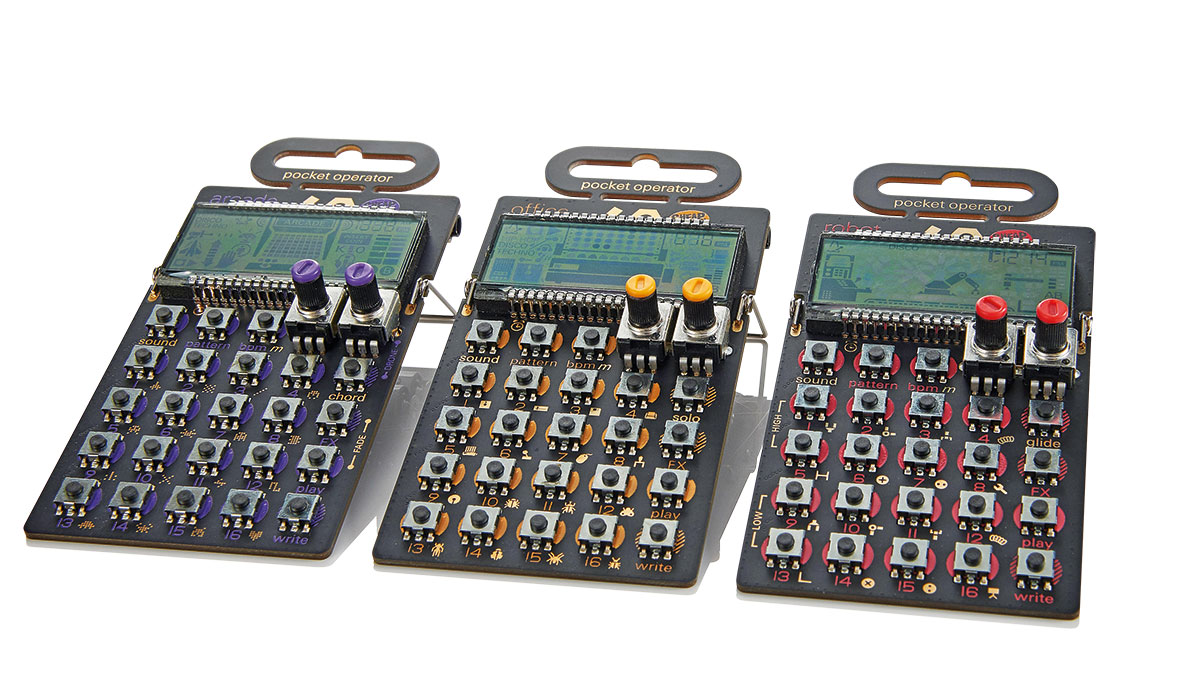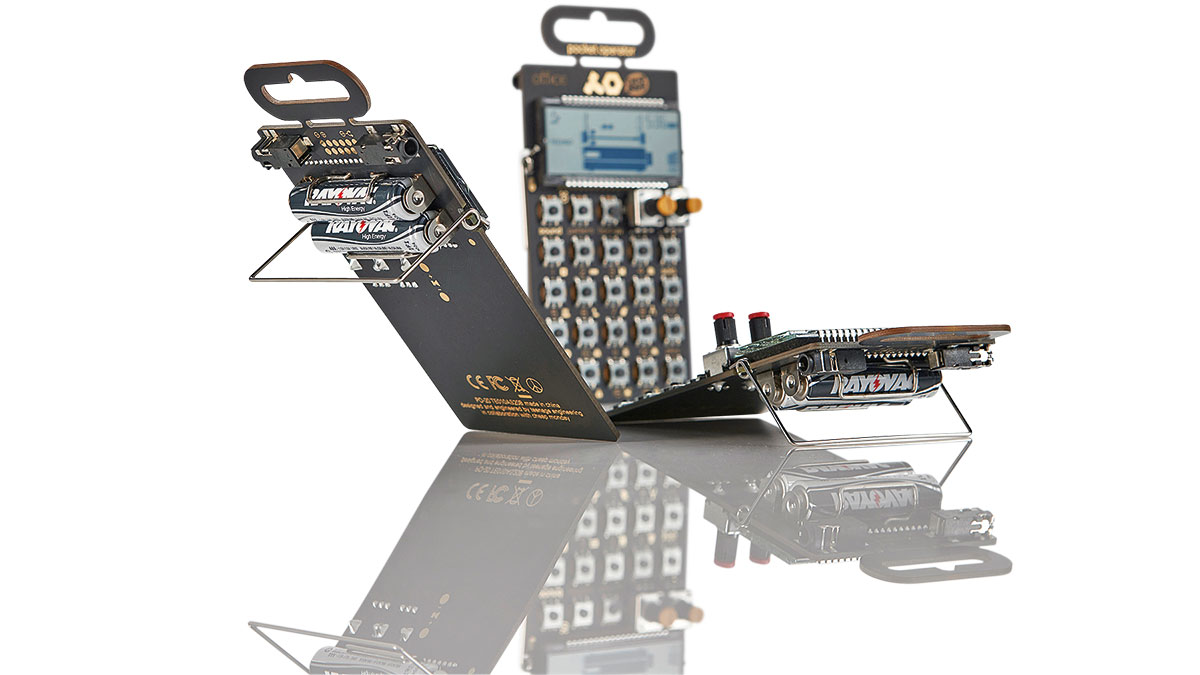MusicRadar Verdict
They may be fiddly, but the POs remain a great-value source of inspiring sounds and sonic fun.
Pros
- +
Great fun.
Cons
- -
A tad fiddly.
MusicRadar's got your back

Teenage Engineering Pocket Operator -20, -24 and -28

Teenage Engineering Pocket Operator -20, -24 and -28
This time last year, esoteric Swedish outfit Teenage Engineering set pulses racing with the announcement of its Pocket Operator range - a trio of compact grooveboxes built into slightly crude, calculator-like bodies, complete with built-in speakers and quirky LCD screens inspired by a bygone age of pocket arcade games.
As with Teenage Engineering's previous instrument, the OP-1, the POs had an appealing quirkiness to them, with a distinct design and sonic palette unlike anything else out there right now.
Unlike their predecessor, however, the POs also came at an affordable price point to suit their portable, rough-and-ready approach.
Now, 12 months on, TE has added three more instruments to the range, once again designed in collaboration with clothing brand Cheap Monday (although we're still not entirely sure what their input entails) each with a new range of sounds and a slightly differing feature set.
If anything, these second-generation POs are even more esoteric than the original trio.
Whereas the PO-12, -14 and -16, focused on bass, beats and leads respectively - albeit each in a slightly unique way - these new instruments are a little less straightforward in their sonic demarcations.
The PO-20 Arcade is branded an 'arcade synthesizer' and is probably most easily described as a Chiptune groovebox, capable of both crunchy bitcrushed beats and video game-like melodic sequences.
The PO-28 Robot, meanwhile, follows a similarly retro path, offering a performance-focused 8-bit lead synth and a pleasingly lo-fi 16-part drum kit. The PO-24 Office - which TE describe as a 'noise percussion drum machine' - is the least straightforward of the three.
In practice those 'noises' are a mixture of glitchy synth sounds and samples pulled from an assortment of outdated pieces of office hardware, such as floppy disk drives and a matrix printer. The result is a gritty, unique sounding groovebox that lends itself particularly well to more experimental forms of electronic music.
LCD soundsystems
For the most part, the form and feature sets of these new POs remain largely the same as that of the original trio. There's a wire stand on the back of each unit, along with breakaway hanger on the top.
As before, each instrument runs on a pair of AAA batteries and features a built-in speaker hidden behind the LCD screen. Again, those screens themselves are more there to add a bit of retro style than for any practical applications; they'll tell you tempo and swing info, and function as a calculator, but the animations don't offer much in the way of useful info.
Each PO features 3.5mm input and output jacks, which function as audio ins and outs but are also used for syncing the POs. Multiple units can be sync'd, passing audio on one channel of the stereo in/out and sync messages on the other, which allows the whole range of POs to function as one large instrument with a single audio output.
The same inputs allow the POs to be sync'd with other gear that uses a pulse-based sync system, such as Korg's Volca range.
As with their predecessors, each of these new POs offers a range of 16 sounds (or 15 synth sounds and one 16-part drum kit, in the case of the PO-28) accompanied by 16 performance-focused effects.
Each also features a 16-step sequencer, with 16 slots for saving patterns, and this new trio of POs allow up to 128 sequencer patterns to be chained together. Each features a step multiplier function too, for making beat-repeater style retriggered sounds.
Most parameter tweaking is handled by a pair of slightly fiddly rotaries to the top right. These are used for editing individual sounds (edits can be 'locked' and written into the pattern), as well as editing step release length and adjusting tempo and swing. Each of the three has a unique feature of its own too.
The PO-20 has a Chord mode, which allows polyphonic sequences to be created, the PO-24 has Solo mode for each of its sounds, while PO-28 has a Glide function, which can add expression and create vibrato in conjunction with the two rotaries.
It takes two
As with the original run, there are a number of criticisms that could be levelled at these latest POs if we were being ultra-critical. They're undoubtedly fiddly and not particularly intuitive either. By their very nature, build quality is pretty basic, and the screens are very much style over substance.
Once again though, given their price and how much functionality TE cram into each tiny device, it's not really worth splitting hairs over these minor limitations.
Each is a lot of fun and, most importantly, the onboard sounds are all great - even if these latest additions are more niche concerns than the originals. True, if you're not into 8-bit/arcade style sounds, you'll likely not get very much out of the PO-20 or PO-28, but that's not to say that they're novelty instruments.
There's a really lovely crunchy quality to the sequences that tumble out of the PO-20, while the Glide function on the PO-28 makes for some really excellent '80s soundtrack-style expressive leads.
The PO-24 is a personal favourite from the range - its onboard assortment of thumps, buzzes and clicks may be an acquired taste, but it makes for a really unique and inspiring sound source.
For all three, however, it's the effects range that really brings the POs to life. The well-selected range of filters, distortions and rhythmic effects are perfectly calibrated to suit the built-in sounds and vastly multiply the potential of each.
They may be a little cheap and cheerful, but you get more than your money's worth in terms of range and tweakability.
I'm the Managing Editor of Music Technology at MusicRadar and former Editor-in-Chief of Future Music, Computer Music and Electronic Musician. I've been messing around with music tech in various forms for over two decades. I've also spent the last 10 years forgetting how to play guitar. Find me in the chillout room at raves complaining that it's past my bedtime.









